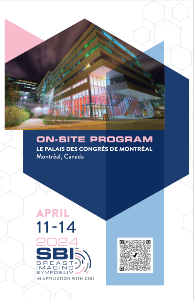Back
Session 2: Healthcare Inequities in Out-of-Pocket Supplemental Breast Cancer Screening
Friday, April 12, 2024
1:30 PM – 2:30 PM
Location: 510B

Lauren Burkard-Mandel, MD, PhD
Diagnostic Radiology Resident
Case Western Reserve University/University Hospitals Cleveland Medical Center
Abstract Presenter(s)
Purpose: Abbreviated MRI (AB-MR) is a supplemental imaging tool which has demonstrated increased sensitivity for breast cancer detection, especially in women with dense breast tissue. Unfortunately, AB-MR is not currently covered by insurance and requires patients to pay an out-of-pocket fee. While less than the cost of a full clinical MRI scan, this fee ($250 at our institution) can be prohibitive for many patients. We hypothesize that this fee creates a barrier for economically disadvantaged communities resulting in limited access to supplemental breast cancer screening and health inequities.
Materials and Methods: Patient demographics were obtained for 1338 women (age = 24 to 90 years) who underwent AB-MR in our Northeast Ohio healthcare system between February 2018 and February 2020. Zip code data, available for 1294 women, was compared with US Census Data on median household income, percent persons in poverty, and percent persons uninsured.
Results: Of the women screened by MR-AB, 91.6% (1225/1338) were Caucasian, 4.6% (61/1338), were African-American, 1.3% (13/1338) were of Asian descent, and 0.1% (2/1338) of women were Native American or Alaskan in stark contrast with census data for Cuyahoga County (63.1% Caucasian, 30.5% African-American, 3.5% Asian, and 0.3% Native American or Alaskan). From the zip code analysis, higher median household incomes were associated with increased prevalence of AB-MR scanning. Over half of the patients screened (681/1294, 53%) were from the two highest median household income brackets ($76,829-$101,118 and $101,125-$250,000), and 64% of patients (863/1294) were from zip codes reporting < 10% of persons in poverty. In contrast, only 18% of patients scanned were from zip codes with >20% persons in poverty, despite a similar or larger female population within those zip codes. Further, 56% (731/1294) of patients were from zip codes with < 5% of uninsured persons, while only 4.2% (54/1294) of patients were from zip codes where >10% of people are uninsured.
Conclusion: While AB-MR has been shown to provide improved detection of breast cancers, out-of-pocket supplemental screening methods such as this are also contributing to worsening healthcare inequities. Our study demonstrated healthcare disparities through multiple socioeconomic factors including race, median household income, regional poverty levels, and the percentage of persons uninsured. As we work to improve breast cancer screening for all women, we must consider the socioeconomic impact of factors such as out-of-pocket supplemental screening which can further increase healthcare inequities.
Clinical Relevance Statement: While supplemental breast MRI screening increases breast cancer detection, out-of-pocket fees for screening contributes to worsening healthcare inequities.
Materials and Methods: Patient demographics were obtained for 1338 women (age = 24 to 90 years) who underwent AB-MR in our Northeast Ohio healthcare system between February 2018 and February 2020. Zip code data, available for 1294 women, was compared with US Census Data on median household income, percent persons in poverty, and percent persons uninsured.
Results: Of the women screened by MR-AB, 91.6% (1225/1338) were Caucasian, 4.6% (61/1338), were African-American, 1.3% (13/1338) were of Asian descent, and 0.1% (2/1338) of women were Native American or Alaskan in stark contrast with census data for Cuyahoga County (63.1% Caucasian, 30.5% African-American, 3.5% Asian, and 0.3% Native American or Alaskan). From the zip code analysis, higher median household incomes were associated with increased prevalence of AB-MR scanning. Over half of the patients screened (681/1294, 53%) were from the two highest median household income brackets ($76,829-$101,118 and $101,125-$250,000), and 64% of patients (863/1294) were from zip codes reporting < 10% of persons in poverty. In contrast, only 18% of patients scanned were from zip codes with >20% persons in poverty, despite a similar or larger female population within those zip codes. Further, 56% (731/1294) of patients were from zip codes with < 5% of uninsured persons, while only 4.2% (54/1294) of patients were from zip codes where >10% of people are uninsured.
Conclusion: While AB-MR has been shown to provide improved detection of breast cancers, out-of-pocket supplemental screening methods such as this are also contributing to worsening healthcare inequities. Our study demonstrated healthcare disparities through multiple socioeconomic factors including race, median household income, regional poverty levels, and the percentage of persons uninsured. As we work to improve breast cancer screening for all women, we must consider the socioeconomic impact of factors such as out-of-pocket supplemental screening which can further increase healthcare inequities.
Clinical Relevance Statement: While supplemental breast MRI screening increases breast cancer detection, out-of-pocket fees for screening contributes to worsening healthcare inequities.

